
Question Number 2400 by Filup last updated on 19/Nov/15
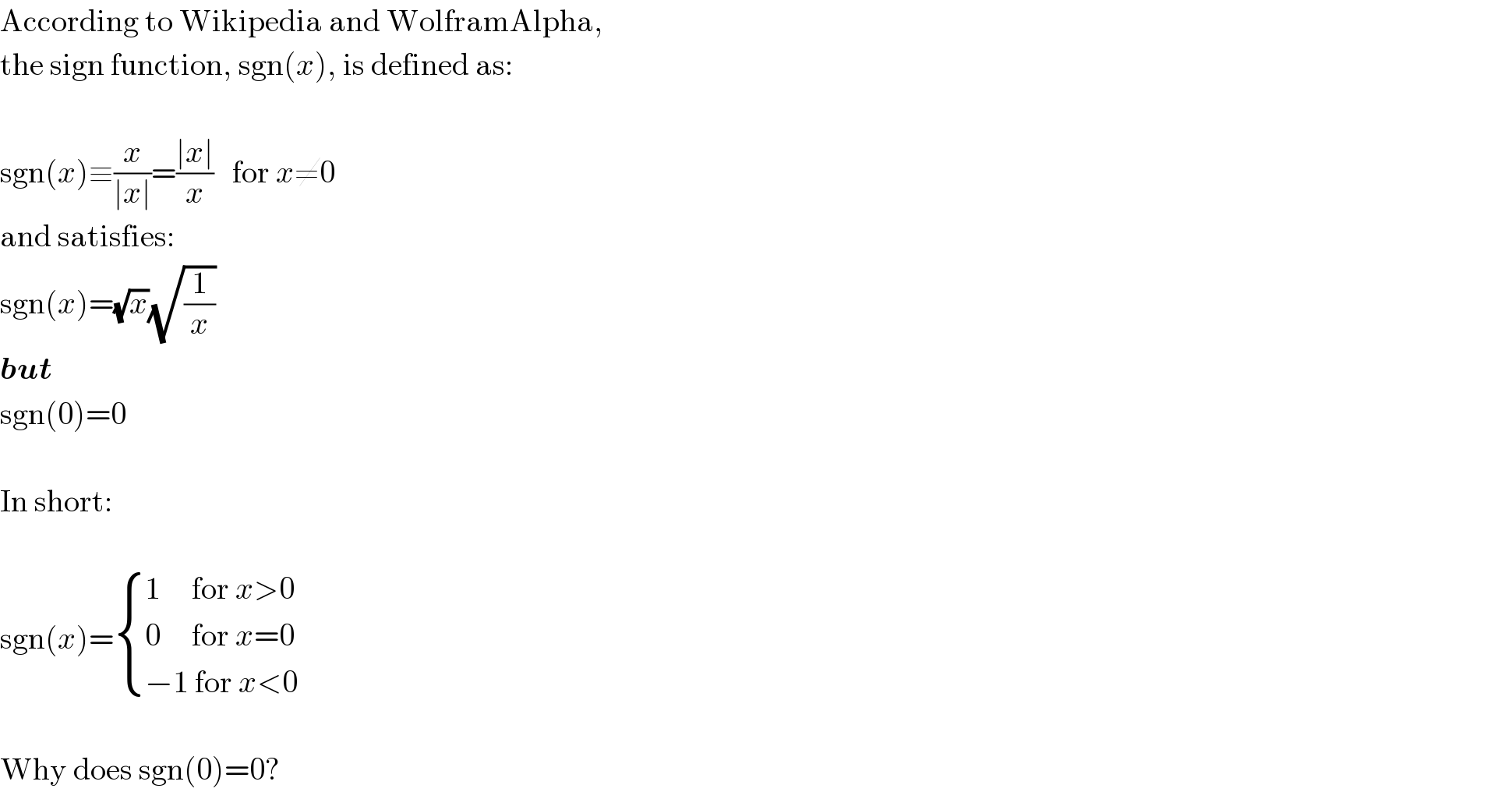
$$\mathrm{According}\:\mathrm{to}\:\mathrm{Wikipedia}\:\mathrm{and}\:\mathrm{WolframAlpha}, \\ $$$$\mathrm{the}\:\mathrm{sign}\:\mathrm{function},\:\mathrm{sgn}\left({x}\right),\:\mathrm{is}\:\mathrm{defined}\:\mathrm{as}: \\ $$$$ \\ $$$$\mathrm{sgn}\left({x}\right)\equiv\frac{{x}}{\mid{x}\mid}=\frac{\mid{x}\mid}{{x}}\:\:\:\mathrm{for}\:{x}\neq\mathrm{0} \\ $$$$\mathrm{and}\:\mathrm{satisfies}: \\ $$$$\mathrm{sgn}\left({x}\right)=\sqrt{{x}}\sqrt{\frac{\mathrm{1}}{{x}}} \\ $$$$\boldsymbol{{but}} \\ $$$$\mathrm{sgn}\left(\mathrm{0}\right)=\mathrm{0} \\ $$$$ \\ $$$$\mathrm{In}\:\mathrm{short}: \\ $$$$ \\ $$$$\mathrm{sgn}\left({x}\right)=\begin{cases}{\mathrm{1}\:\:\:\:\:\mathrm{for}\:{x}>\mathrm{0}}\\{\mathrm{0}\:\:\:\:\:\mathrm{for}\:{x}=\mathrm{0}}\\{−\mathrm{1}\:\mathrm{for}\:{x}<\mathrm{0}}\end{cases} \\ $$$$ \\ $$$$\mathrm{Why}\:\mathrm{does}\:\mathrm{sgn}\left(\mathrm{0}\right)=\mathrm{0}? \\ $$
Commented by Rasheed Soomro last updated on 19/Nov/15
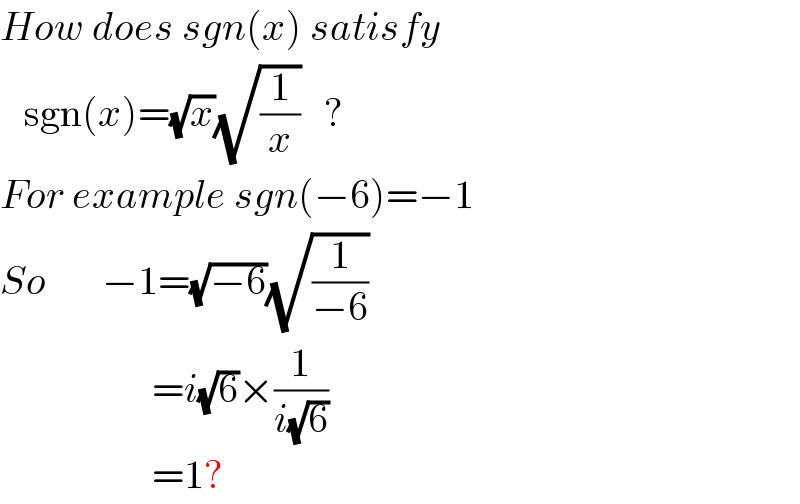
$${How}\:{does}\:{sgn}\left({x}\right)\:{satisfy} \\ $$$$\:\:\:\mathrm{sgn}\left({x}\right)=\sqrt{{x}}\sqrt{\frac{\mathrm{1}}{{x}}}\:\:\:? \\ $$$${For}\:{example}\:{sgn}\left(−\mathrm{6}\right)=−\mathrm{1} \\ $$$${So}\:\:\:\:\:\:\:−\mathrm{1}=\sqrt{−\mathrm{6}}\sqrt{\frac{\mathrm{1}}{−\mathrm{6}}} \\ $$$$\:\:\:\:\:\:\:\:\:\:\:\:\:\:\:\:\:\:\:={i}\sqrt{\mathrm{6}}×\frac{\mathrm{1}}{{i}\sqrt{\mathrm{6}}} \\ $$$$\:\:\:\:\:\:\:\:\:\:\:\:\:\:\:\:\:\:\:=\mathrm{1}? \\ $$
Commented by Filup last updated on 20/Nov/15

$$\mathrm{I}'\mathrm{m}\:\mathrm{not}\:\mathrm{sure}\:\mathrm{how}\:\mathrm{it}\:\mathrm{satisfies}.\:\mathrm{That}\:\mathrm{was} \\ $$$$\mathrm{Just}\:\mathrm{what}\:\mathrm{I}\:\mathrm{found}\:\mathrm{online} \\ $$
Commented by Rasheed Soomro last updated on 20/Nov/15
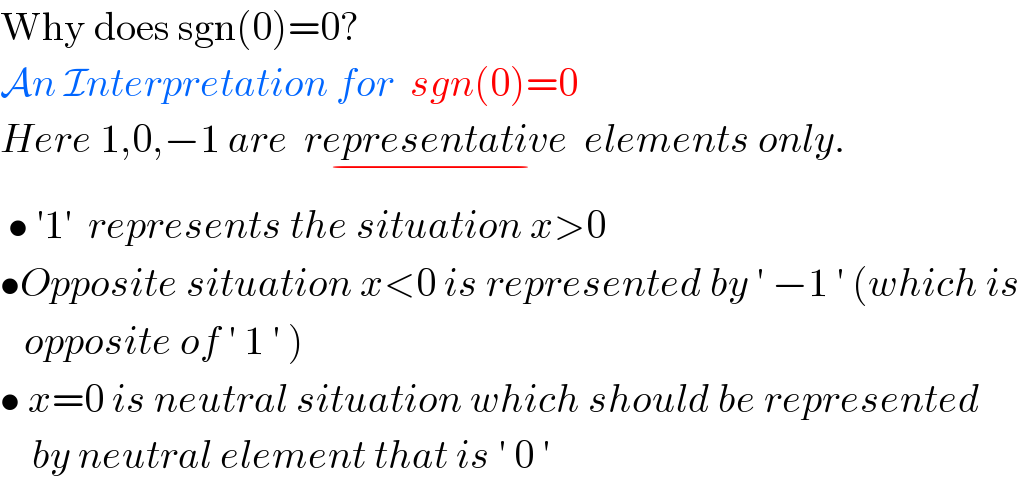
$$\mathrm{Why}\:\mathrm{does}\:\mathrm{sgn}\left(\mathrm{0}\right)=\mathrm{0}? \\ $$$$\mathcal{A}{n}\:\mathcal{I}{nterpretation}\:{for}\:\:{sgn}\left(\mathrm{0}\right)=\mathrm{0} \\ $$$${Here}\:\mathrm{1},\mathrm{0},−\mathrm{1}\:{are}\:\:\underset{−} {{representative}}\:\:{elements}\:{only}. \\ $$$$\:\bullet\:'\mathrm{1}'\:\:{represents}\:{the}\:{situation}\:{x}>\mathrm{0}\: \\ $$$$\bullet{Opposite}\:{situation}\:{x}<\mathrm{0}\:{is}\:{represented}\:{by}\:'\:−\mathrm{1}\:'\:\left({which}\:{is}\right. \\ $$$$\left.\:\:\:{opposite}\:{of}\:'\:\mathrm{1}\:'\:\right) \\ $$$$\bullet\:{x}=\mathrm{0}\:{is}\:{neutral}\:{situation}\:{which}\:{should}\:{be}\:{represented} \\ $$$$\:\:\:\:{by}\:{neutral}\:{element}\:{that}\:{is}\:'\:\mathrm{0}\:' \\ $$
Commented by prakash jain last updated on 20/Nov/15
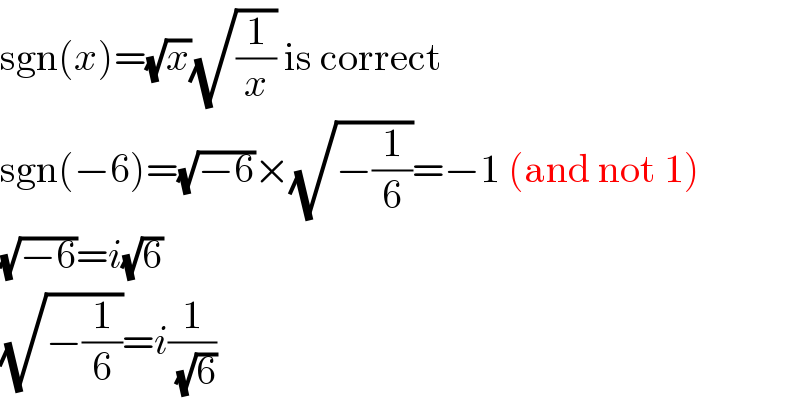
$$\mathrm{sgn}\left({x}\right)=\sqrt{{x}}\sqrt{\frac{\mathrm{1}}{{x}}}\:\mathrm{is}\:\mathrm{correct} \\ $$$$\mathrm{sgn}\left(−\mathrm{6}\right)=\sqrt{−\mathrm{6}}×\sqrt{−\frac{\mathrm{1}}{\mathrm{6}}}=−\mathrm{1}\:\left(\mathrm{and}\:\mathrm{not}\:\mathrm{1}\right) \\ $$$$\sqrt{−\mathrm{6}}={i}\sqrt{\mathrm{6}} \\ $$$$\sqrt{−\frac{\mathrm{1}}{\mathrm{6}}}={i}\frac{\mathrm{1}}{\sqrt{\mathrm{6}}} \\ $$
Answered by 123456 last updated on 19/Nov/15
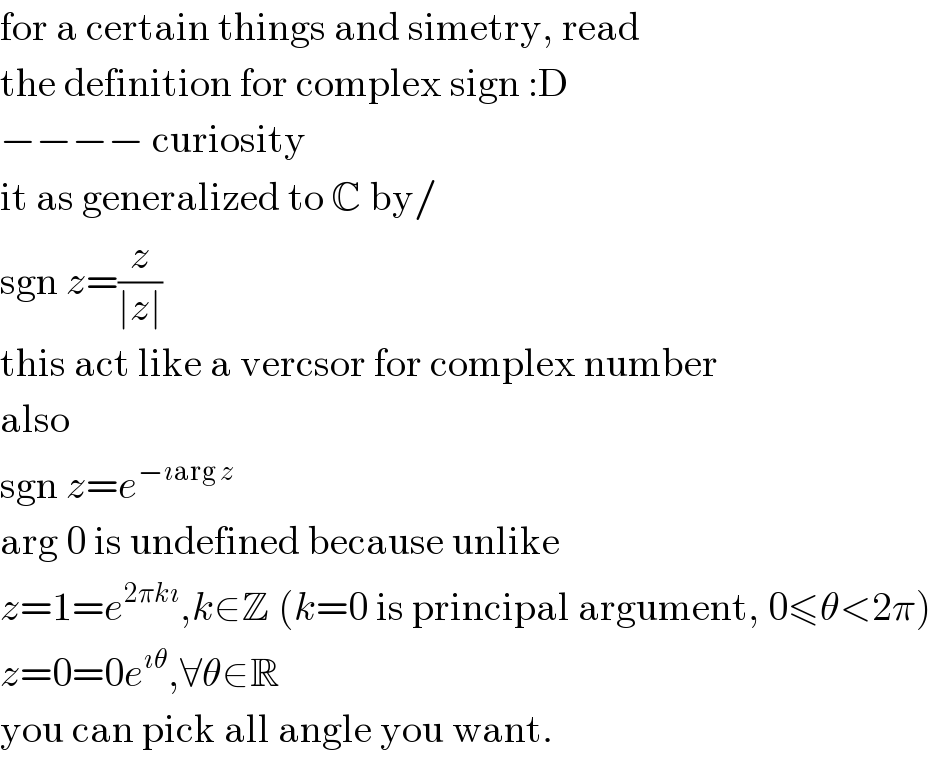
$$\mathrm{for}\:\mathrm{a}\:\mathrm{certain}\:\mathrm{things}\:\mathrm{and}\:\mathrm{simetry},\:\mathrm{read} \\ $$$$\mathrm{the}\:\mathrm{definition}\:\mathrm{for}\:\mathrm{complex}\:\mathrm{sign}\::\mathrm{D} \\ $$$$−−−−\:\mathrm{curiosity} \\ $$$$\mathrm{it}\:\mathrm{as}\:\mathrm{generalized}\:\mathrm{to}\:\mathbb{C}\:\mathrm{by}/ \\ $$$$\mathrm{sgn}\:{z}=\frac{{z}}{\mid{z}\mid} \\ $$$$\mathrm{this}\:\mathrm{act}\:\mathrm{like}\:\mathrm{a}\:\mathrm{vercsor}\:\mathrm{for}\:\mathrm{complex}\:\mathrm{number} \\ $$$$\mathrm{also} \\ $$$$\mathrm{sgn}\:{z}={e}^{−\imath\mathrm{arg}\:{z}} \\ $$$$\mathrm{arg}\:\mathrm{0}\:\mathrm{is}\:\mathrm{undefined}\:\mathrm{because}\:\mathrm{unlike} \\ $$$${z}=\mathrm{1}={e}^{\mathrm{2}\pi{k}\imath} ,{k}\in\mathbb{Z}\:\left({k}=\mathrm{0}\:\mathrm{is}\:\mathrm{principal}\:\mathrm{argument},\:\mathrm{0}\leqslant\theta<\mathrm{2}\pi\right) \\ $$$${z}=\mathrm{0}=\mathrm{0}{e}^{\imath\theta} ,\forall\theta\in\mathbb{R} \\ $$$$\mathrm{you}\:\mathrm{can}\:\mathrm{pick}\:\mathrm{all}\:\mathrm{angle}\:\mathrm{you}\:\mathrm{want}. \\ $$
Commented by Rasheed Soomro last updated on 19/Nov/15
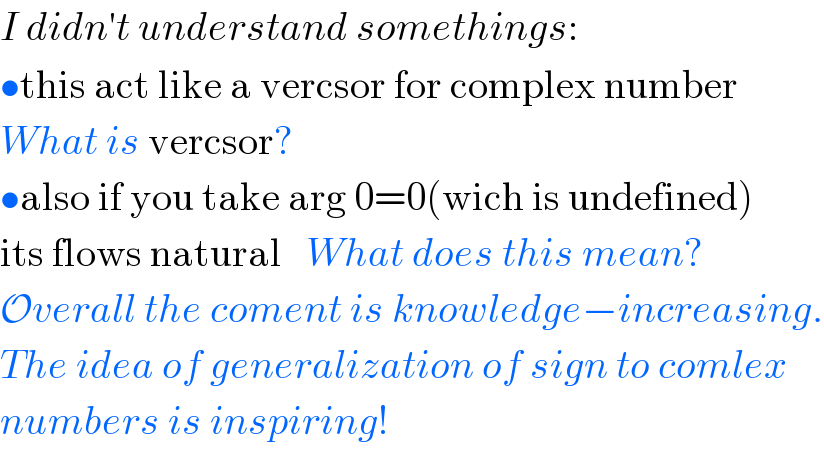
$${I}\:{didn}'{t}\:{understand}\:{somethings}: \\ $$$$\bullet\mathrm{this}\:\mathrm{act}\:\mathrm{like}\:\mathrm{a}\:\mathrm{vercsor}\:\mathrm{for}\:\mathrm{complex}\:\mathrm{number} \\ $$$${What}\:{is}\:\mathrm{vercsor}? \\ $$$$\bullet\mathrm{also}\:\mathrm{if}\:\mathrm{you}\:\mathrm{take}\:\mathrm{arg}\:\mathrm{0}=\mathrm{0}\left(\mathrm{wich}\:\mathrm{is}\:\mathrm{undefined}\right) \\ $$$$\mathrm{its}\:\mathrm{flows}\:\mathrm{natural}\:\:\:{What}\:{does}\:{this}\:{mean}? \\ $$$$\mathcal{O}{verall}\:{the}\:{coment}\:{is}\:{knowledge}−{increasing}. \\ $$$${The}\:{idea}\:{of}\:{generalization}\:{of}\:{sign}\:{to}\:{comlex}\: \\ $$$${numbers}\:{is}\:{inspiring}! \\ $$
Commented by Filup last updated on 19/Nov/15

$$\mathrm{What}\:\mathrm{is}\:\mathrm{arg}\left({z}\right)? \\ $$$$\mathrm{I}'\mathrm{ve}\:\mathrm{seen}\:\mathrm{it}\:\mathrm{before} \\ $$
Commented by 123456 last updated on 19/Nov/15

$$\mathrm{the}\:\mathrm{argument}\:\mathrm{of}\:\mathrm{the}\:\mathrm{complex}\:\mathrm{number} \\ $$$$\mathrm{if}\:\mathrm{you}\:\mathrm{consider}\:\mathrm{the}\:\mathrm{complex}\:\mathrm{a}\:\mathrm{vector} \\ $$$$\mathrm{it}\:\mathrm{is}\:\mathrm{the}\:\mathrm{angle}\:\mathrm{of}\:\mathrm{it}\:\mathrm{and}\:\mathrm{the}\:\mathrm{real}\:\mathrm{axis} \\ $$
Commented by Filup last updated on 19/Nov/15

$$\mathrm{I}\:\mathrm{see}.\:\mathrm{I}\:\mathrm{haven}'\mathrm{t}\:\mathrm{leant}\:\mathrm{much}\:\mathrm{on}\:\mathrm{the}\:\mathrm{complex} \\ $$$$\mathrm{plane},\:\mathrm{so}\:\mathrm{this}\:\mathrm{interests}\:\mathrm{me}.\:\mathrm{I}'\mathrm{ll}\:\mathrm{have}\:\mathrm{to} \\ $$$$\mathrm{take}\:\mathrm{a}\:\mathrm{look}\:\mathrm{at}\:\mathrm{complex}\:\mathrm{mathematics}! \\ $$
Commented by Rasheed Soomro last updated on 19/Nov/15

$$\mathcal{TH}{ank}^{\mathcal{S}} \\ $$
Commented by 123456 last updated on 19/Nov/15
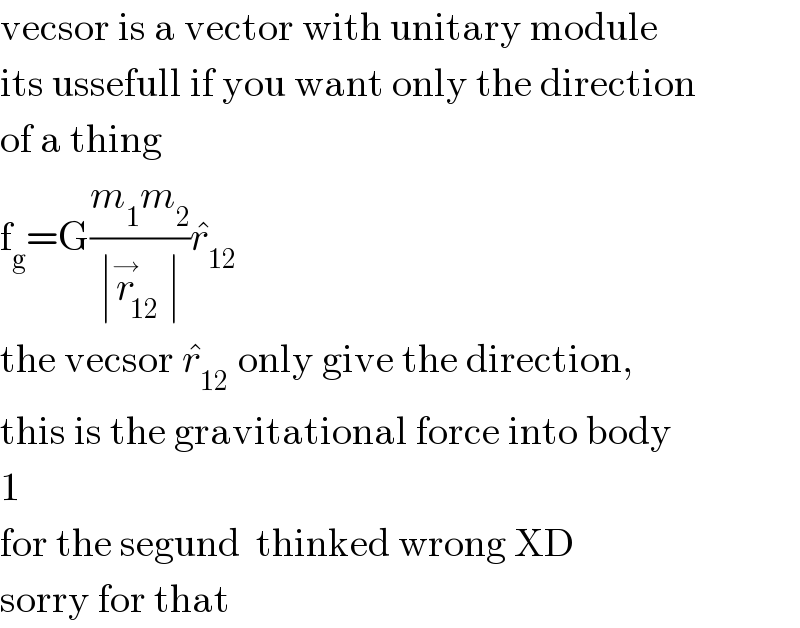
$$\mathrm{vecsor}\:\mathrm{is}\:\mathrm{a}\:\mathrm{vector}\:\mathrm{with}\:\mathrm{unitary}\:\mathrm{module} \\ $$$$\mathrm{its}\:\mathrm{ussefull}\:\mathrm{if}\:\mathrm{you}\:\mathrm{want}\:\mathrm{only}\:\mathrm{the}\:\mathrm{direction} \\ $$$$\mathrm{of}\:\mathrm{a}\:\mathrm{thing} \\ $$$$\mathrm{f}_{\mathrm{g}} =\mathrm{G}\frac{{m}_{\mathrm{1}} {m}_{\mathrm{2}} }{\mid\overset{\rightarrow} {{r}}_{\mathrm{12}} \mid}\hat {{r}}_{\mathrm{12}} \\ $$$$\mathrm{the}\:\mathrm{vecsor}\:\hat {{r}}_{\mathrm{12}} \:\mathrm{only}\:\mathrm{give}\:\mathrm{the}\:\mathrm{direction}, \\ $$$$\mathrm{this}\:\mathrm{is}\:\mathrm{the}\:\mathrm{gravitational}\:\mathrm{force}\:\mathrm{into}\:\mathrm{body} \\ $$$$\mathrm{1} \\ $$$$\mathrm{for}\:\mathrm{the}\:\mathrm{segund}\:\:\mathrm{thinked}\:\mathrm{wrong}\:\mathrm{XD} \\ $$$$\mathrm{sorry}\:\mathrm{for}\:\mathrm{that} \\ $$
Commented by Rasheed Soomro last updated on 20/Nov/15

$${I}\:{want}\:{to}\:{understand}\:{clearly}: \\ $$$${If}\:{z}={a}+{ib}\:{then} \\ $$$${sgn}\left({a}+{ib}\right)=\frac{{a}+{ib}}{\mid{a}+{ib}\mid}=\frac{{a}}{\sqrt{{a}^{\mathrm{2}} +{b}^{\mathrm{2}} }}+\frac{{ib}}{\sqrt{{a}^{\mathrm{2}} +{b}^{\mathrm{2}} }} \\ $$$${Clearly}\:\:{all}\:{z}\:{having}\:{same}\:\mid{z}\mid\:{have}\:{same}\:{sgn}\left({z}\right)! \\ $$$${Do}\:{all}\:{complex}\:{numbers}\:{having}\:{same}\:{absolute}\:{value} \\ $$$${have}\:{same}\:{sign}? \\ $$
Commented by Filup last updated on 20/Nov/15
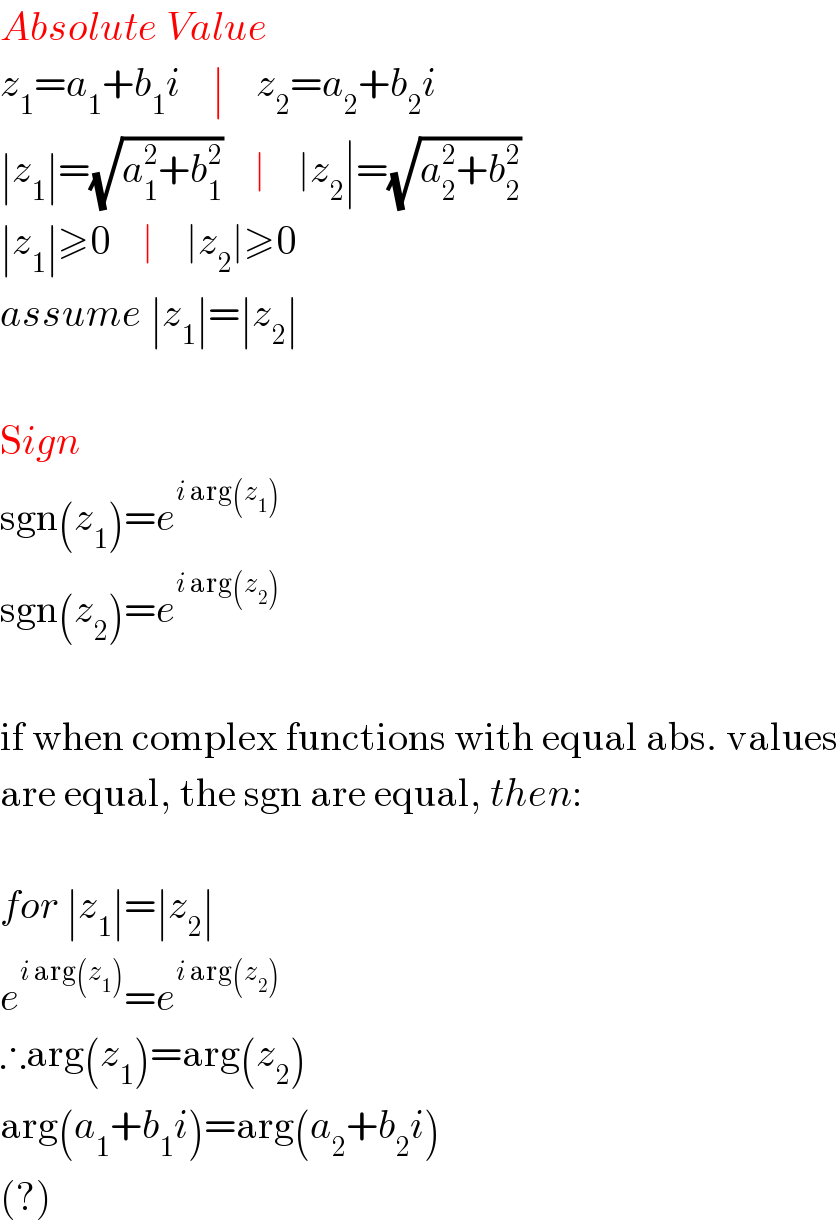
$${Absolute}\:{Value} \\ $$$${z}_{\mathrm{1}} ={a}_{\mathrm{1}} +{b}_{\mathrm{1}} {i}\:\:\:\:\mid\:\:\:\:{z}_{\mathrm{2}} ={a}_{\mathrm{2}} +{b}_{\mathrm{2}} {i} \\ $$$$\mid{z}_{\mathrm{1}} \mid=\sqrt{{a}_{\mathrm{1}} ^{\mathrm{2}} +{b}_{\mathrm{1}} ^{\mathrm{2}} }\:\:\:\:\mid\:\:\:\:\mid{z}_{\mathrm{2}} \mid=\sqrt{{a}_{\mathrm{2}} ^{\mathrm{2}} +{b}_{\mathrm{2}} ^{\mathrm{2}} } \\ $$$$\mid{z}_{\mathrm{1}} \mid\geqslant\mathrm{0}\:\:\:\:\mid\:\:\:\:\mid{z}_{\mathrm{2}} \mid\geqslant\mathrm{0} \\ $$$${assume}\:\mid{z}_{\mathrm{1}} \mid=\mid{z}_{\mathrm{2}} \mid \\ $$$$ \\ $$$$\mathrm{S}{ign} \\ $$$$\mathrm{sgn}\left({z}_{\mathrm{1}} \right)={e}^{{i}\:\mathrm{arg}\left({z}_{\mathrm{1}} \right)} \\ $$$$\mathrm{sgn}\left({z}_{\mathrm{2}} \right)={e}^{{i}\:\mathrm{arg}\left({z}_{\mathrm{2}} \right)} \\ $$$$ \\ $$$$\mathrm{if}\:\mathrm{when}\:\mathrm{complex}\:\mathrm{functions}\:\mathrm{with}\:\mathrm{equal}\:\mathrm{abs}.\:\mathrm{values} \\ $$$$\mathrm{are}\:\mathrm{equal},\:\mathrm{the}\:\mathrm{sgn}\:\mathrm{are}\:\mathrm{equal},\:{then}: \\ $$$$ \\ $$$${for}\:\mid{z}_{\mathrm{1}} \mid=\mid{z}_{\mathrm{2}} \mid \\ $$$${e}^{{i}\:\mathrm{arg}\left({z}_{\mathrm{1}} \right)} ={e}^{{i}\:\mathrm{arg}\left({z}_{\mathrm{2}} \right)} \\ $$$$\therefore\mathrm{arg}\left({z}_{\mathrm{1}} \right)=\mathrm{arg}\left({z}_{\mathrm{2}} \right) \\ $$$$\mathrm{arg}\left({a}_{\mathrm{1}} +{b}_{\mathrm{1}} {i}\right)=\mathrm{arg}\left({a}_{\mathrm{2}} +{b}_{\mathrm{2}} {i}\right) \\ $$$$\left(?\right) \\ $$
Commented by 123456 last updated on 20/Nov/15

$${z}_{\mathrm{1}} \:\mathrm{and}\:{z}_{\mathrm{2}} \:\mathrm{have}\:\mathrm{same}\:\mathrm{sign}\:\mathrm{only}\:\mathrm{if} \\ $$$$\exists\lambda\in\mathbb{R},\mathrm{0}<\lambda<+\infty\:\mathrm{such}\:\mathrm{that} \\ $$$${z}_{\mathrm{2}} =\lambda{z}_{\mathrm{1}} \\ $$
Commented by prakash jain last updated on 20/Nov/15
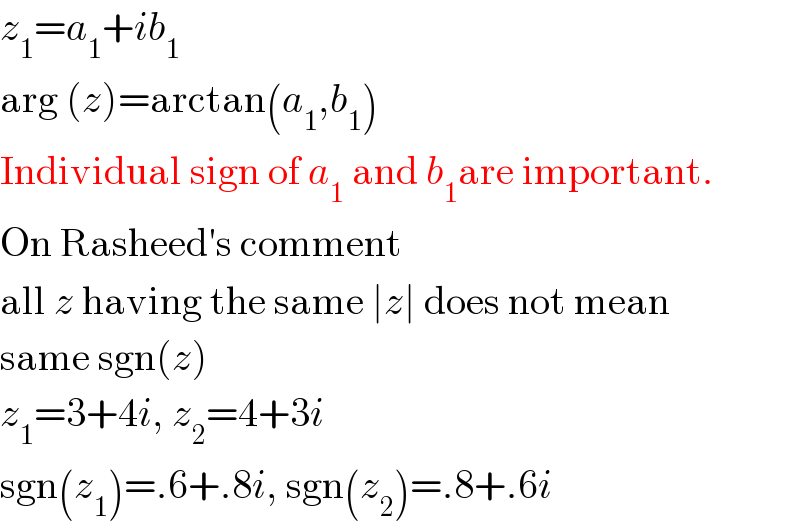
$${z}_{\mathrm{1}} ={a}_{\mathrm{1}} +{ib}_{\mathrm{1}} \\ $$$$\mathrm{arg}\:\left({z}\right)=\mathrm{arctan}\left({a}_{\mathrm{1}} ,{b}_{\mathrm{1}} \right) \\ $$$$\mathrm{Individual}\:\mathrm{sign}\:\mathrm{of}\:{a}_{\mathrm{1}} \:\mathrm{and}\:{b}_{\mathrm{1}} \mathrm{are}\:\mathrm{important}. \\ $$$$\mathrm{On}\:\mathrm{Rasheed}'\mathrm{s}\:\mathrm{comment} \\ $$$$\mathrm{all}\:{z}\:\mathrm{having}\:\mathrm{the}\:\mathrm{same}\:\mid{z}\mid\:\mathrm{does}\:\mathrm{not}\:\mathrm{mean} \\ $$$$\mathrm{same}\:\mathrm{sgn}\left({z}\right) \\ $$$${z}_{\mathrm{1}} =\mathrm{3}+\mathrm{4}{i},\:{z}_{\mathrm{2}} =\mathrm{4}+\mathrm{3}{i} \\ $$$$\mathrm{sgn}\left({z}_{\mathrm{1}} \right)=.\mathrm{6}+.\mathrm{8}{i},\:\mathrm{sgn}\left({z}_{\mathrm{2}} \right)=.\mathrm{8}+.\mathrm{6}{i} \\ $$
Commented by Rasheed Soomro last updated on 20/Nov/15

$$\mathcal{THANKS}\:\:\mathcal{T}{o}\:\mathcal{A}{ll}\:{of}\:\:\mathcal{Y}{ou}!\: \\ $$$$\mathcal{I}\:\:\mathcal{W}{as}\:\:\mathcal{I}{n}\:\mathcal{M}{is}\mathcal{U}{nderstanding}. \\ $$
